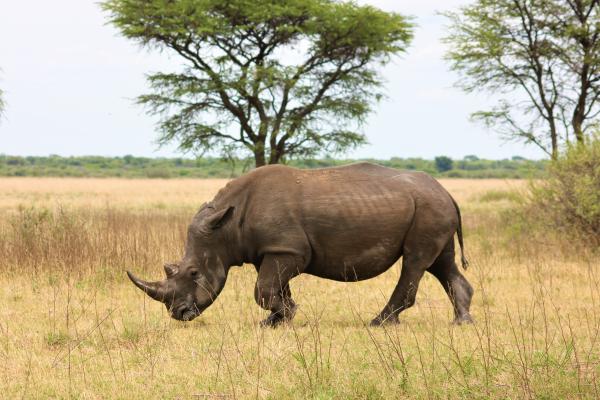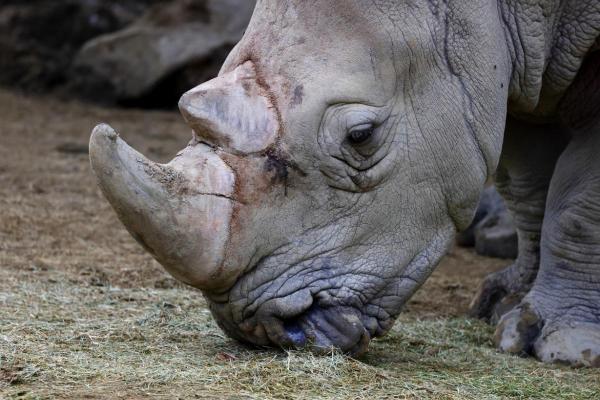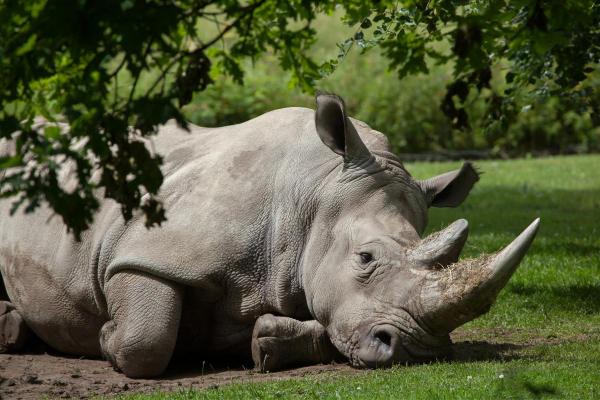How Many White Rhinos Remain in the Wild Today?


One of the most recognizable and endangered animals in the world, the white rhino, is at a turning point in its history. The amazing recovery of the southern white rhino, which was once in danger of going extinct, is evidence of the effectiveness of committed conservation efforts. But the battle is far from over.
This AnimalWised article examines the present situation of white rhinos, explores the factors contributing to their decline, and highlights ongoing efforts to preserve their existence.
Overview of white rhinos
White rhinos, also known as square-lipped rhinoceroses, are one of the five extant species of rhinoceroses.
They are the largest of all rhino species and the second-largest land mammal after the elephant. Despite their name, white rhinos are not actually white; their skin is a grayish color.
White rhinos are massive animals, with adults weighing between 1,800 and 2,700 kilograms (4,000 to 6,000 pounds). They have a distinctive hump on their necks, which supports their large heads. Their broad, flat mouths are specially adapted for grazing on grass, which makes up the majority of their diet.
In terms of habitat, white rhinos prefer savannas, grasslands, and open woodlands, where they can find abundant grass and access to water sources. They are social animals, often seen in small groups known as crashes, which typically consist of females and their calves. Male white rhinos are more solitary and territorial, marking their areas with dung and urine to ward off rivals.
There are two subspecies of white rhinos:
- Northern white rhino (Ceratotherium simum cottoni)
- Southern white rhino (Ceratotherium simum simum)
Want to learn more about the rhino family tree? Dive into our exploration of different rhino species.

Current population of white rhinos
As previously mentioned, the two white rhino subspecies face very different conservation statuses, reflected in their disparate population numbers:
Northern white rhino:
This subspecies is critically endangered, with only two individuals remaining, both of which are female. These two rhinos, Najin and Fatu, live under heavy protection at the Ol Pejeta Conservancy in Kenya.
The last male, Sudan, died in 2018, but sperm samples were preserved to aid in advanced reproductive efforts such as in vitro fertilization (IVF). Scientists have successfully produced viable embryos using these samples and eggs from the females, with the hope of implanting them into southern white rhino surrogates.
Southern white rhino:
The Southern white rhino is more numerous, with a population of approximately 17,464 individuals as of 2023. Thanks to successful conservation programs, their numbers have recovered significantly from near extinction in the late 19th century, when only 20 to 50 individuals remained.
Small subpopulations have been reintroduced in Botswana, Namibia, Eswatini, Zimbabwe, and even non-native areas like Kenya, Zambia, and Uganda.

Conservation Status of the white rhinoceros
The white rhinoceros (Ceratotherium simum) is classified as Near Threatened by the IUCN Red List. This classification reflects the ongoing threat of poaching, which continues to impact the species despite significant conservation efforts.
However, it's crucial to distinguish between the two subspecies:
Northern white rhinoceros (Ceratotherium simum cottoni):
This subspecies is listed as Critically Endangered (Possibly Extinct in the Wild). Only two females remain, and no wild populations are known to exist. This makes them functionally extinct in the wild.
Southern white rhinoceros (Ceratotherium simum simum):
While the white rhino species as a whole is Near Threatened due to the critical status of the Northern subspecies, the Southern white rhino has experienced a significant population recovery. It is not considered as immediately threatened as its northern counterpart.
Therefore, while the white rhinoceros species is Near Threatened, this designation is primarily driven by the near-extinction of the Northern subspecies.
The Southern white rhino population is relatively stable, representing a significant conservation success story, albeit one overshadowed by the tragic decline of its northern relative.

Why is the white rhino endangered?
Both the northern and southern white rhinoceros subspecies face the severe threat of poaching, primarily driven by demand for rhino horn in Asia.
This demand stems from unfounded beliefs in its medicinal properties within traditional medicine and its use as a luxury item and status symbol.
- Northern white rhinoceros: this subspecies has been decimated by poaching, particularly since the early 2000s. Armed conflicts and habitat destruction in the Democratic Republic of Congo further exacerbated their decline, as the regions they once inhabited became unsafe for wildlife.
- Southern white rhinoceros: while currently more numerous, they are also heavily impacted by illegal hunting for their horns. This continuous poaching pressure poses a serious threat to their long-term survival, despite previous conservation successes. Between 2017 and 2023, increased poaching incidents led to a drop in their numbers. In some areas, diseases such as anthrax and bovine tuberculosis have been reported, posing additional risks to certain subpopulations. Changes in weather patterns, including prolonged droughts, can reduce food and water availability, further stressing southern white rhino populations.
It is crucial to emphasize that there is no scientific basis for the purported medicinal benefits of rhino horn. Its use as a luxury item is equally unjustified and contributes directly to the decline of these animals. Want to know more about the landscapes where rhinos roam? Do not miss this other article.
Conservation plans for the white rhinoceros
To address the numerous obstacles the white rhinoceros faces, protection calls for a multifaceted strategy:
- Strengthen sanctuaries and protected areas: secure habitats with effective anti-poaching patrols, well-trained rangers, and good infrastructure are essential for protecting rhino populations. Concentrating rhinos in these areas allows for more efficient monitoring and law enforcement.
- Biological management (translocation): moving rhinos to new or existing protected areas helps establish new populations, increase genetic diversity, and reduce the risk of localized extinctions. This is a crucial tool, particularly for the southern white rhino.
- International coordination: collaboration between countries, NGOs, and organizations like the IUCN African Rhino Specialist Group is vital. This includes sharing information, coordinating anti-poaching efforts, and developing consistent conservation strategies across borders.
- Assisted reproduction techniques: this is particularly relevant to the northern white rhino. Given the extremely low number of remaining individuals, techniques like in vitro fertilization (IVF), artificial insemination, and potentially even stem cell technology are being explored to try and recover the subspecies.
- Reducing demand: This is arguably the most critical long-term strategy. Unless the demand for rhino horn is significantly reduced or eliminated, poaching will continue to threaten rhino populations. Educational campaigns in consumer countries (primarily in Asia) are essential to dispel myths about the medicinal properties of rhino horn and raise awareness about the devastating impact of poaching.
It's critical to understand that these initiatives are interrelated and that their success depends on a multifaceted strategy. The long-term future of these amazing animals depends on addressing both the supply side (preserving rhinos in the wild) and the demand side (decreased desire for rhino horn).
For more information on endangered animal species, take a look at our article on 10 animals in danger of extinction.
If you want to read similar articles to How Many White Rhinos Remain in the Wild Today?, we recommend you visit our Endangered animals category.
- Emslie, R. (2020). Ceratotherium simum . IUCN Red List of Threatened Species 2020: e.T4185A45813880. Available at: https://dx.doi.org/10.2305/IUCN.UK.2020-1.RLTS.T4185A45813880.en
- Emslie, R. (2020). Ceratotherium simum ssp. cottoni . IUCN Red List of Threatened Species 2020: e.T4183A45813838. Available at: https://dx.doi.org/10.2305/IUCN.UK.2020-1.RLTS.T4183A45813838.en
- Emslie, R. (2020). Ceratotherium simum ssp. simmum . IUCN Red List of Threatened Species 2020: e.T39317A45814320. Available at: https://dx.doi.org/10.2305/IUCN.UK.2020-1.RLTS.T39317A45814320.en








